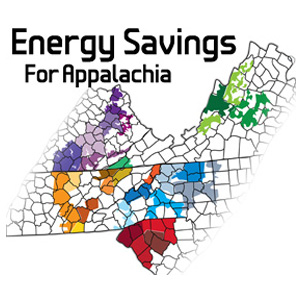Front Porch Blog
By Adam Sheffield, Appalachian Voices Video and Outreach Assistant
Our new video series offers a variety of easy energy efficiency tips to lower electric bills while reducing energy waste.
When it comes to the weather in Appalachia, we’ve got it all. We have bitter cold winters, soaking wet springs, hot humid summers and chilly autumns. Each of the four seasons comes with gifts as well as a set of energy challenges.
Further south, folks face the challenge of cooling the air in their homes, battling humidity and hot temperatures. For people to the north, heating their homes in the winter is the main goal. But here in Appalachia, our mountain climate has characteristics that require our homes to deal with both heat and cold.
Many mountain homes don’t have air conditioning units due to Appalachia’s milder summers, although some newer homes are being built with AC while others install window units. In the winter, it’s difficult to survive the season here without a good heating source. Heating methods vary from home to home, from wood-burning stoves, to propane furnaces, kerosene monitors, or electric baseboard heaters, to central HVAC units.
Regardless of the type of heating system, winter heating costs are a financial burden for many families. Some systems are more expensive than others, and older systems are more costly to use than newer, more energy-efficient models. The point is that we all want to be comfortable during the cold winter months, but we also want to save on our energy costs.
Appalachian Voices’ Energy Savings for Appalachia promotes programs that help Appalachian residents lower their energy costs. Our goal is to create a widespread network of support for energy efficiency financing programs through the rural electric cooperatives. We’re working in western North Carolina and East Tennessee, but we are part of a larger regional and national movement to expand access to affordable home energy efficiency financing for residents of all income levels. Education is a key part of our work to help residents lower their energy costs, so we’ve created a set of short Do-It-Yourself videos.
This short video features John Kidda, founder and president of reNew Homes, Inc., in Boone, N.C. In the video, John discusses using programmable thermostats as a way to save on heating and cooling, and the benefits of using one in an Appalachian home. John points out that lower temperature settings — and lower energy use — during the colder winter season are easier to achieve when the home is properly insulated and air leakage is minimized.
Programmable thermostats allow residents to set the temperature in their home to operate around a schedule. There’s no need to leave the air conditioner or heat running while you’re away at work or school all day. The same goes for winter settings and for the nighttime when you’re asleep. Why run the heat on high when you don’t need to? Program your thermostat to turn the heat on right before your normal wakeup time. Then, set the thermostat to a lower temperature while you’re away from home or headed to bed. Some thermostats can even be adjusted from a mobile device.
Prices range from as low as $50 to over $300. Many programmable thermostats now include instant rebates. By switching to a programmable thermostat, you can lower your energy cost by 10 percent in the first year.
Watch our heating and cooling video and let us know what you think! We will be releasing additional videos in the coming months. If you are interested in learning more, contact me at (828) 262-1500, or by email at adam.sheffield@appvoices.org.
PREVIOUS
NEXT

Leave a comment
Your email address will not be published. Required fields are marked *
One response to “Do-It-Yourself tips for energy efficiency: Heating & Cooling”
-
When you decide on your HVAC system, be sure that you pick a reasonable maintrnance agreement as well.
Retailers can charge more juszt because a unit gets to be a
necessiy during these times. Sadpy enough, the base demand for
shelter, that’s the largest single investment that many folks is likely to make inside our lifetime, is still built and based on existing technology which caan bbe millenia
old.


Leave a Comment